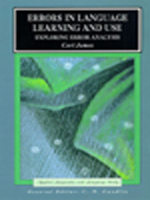Errors in Language Learning & Use
Exploring Error Analysis
By Carl James
January 1998
Pearson Education
ISBN: 0582257638
320 pages
$59.50 Paper Original
Errors in Language Learning and Use is an up-to-date introduction and guide to the study of errors in language, and is also a critical survey of previous work. Error Analysis occupies a central position within Applied Linguistics, and seeks to clarify questions such as `Does correctness matter?', `Is it more important to speak fluently and write imaginatively or to communicate one's message?' Carl James provides a scholarly and well-illustrated theoretical and historical background to the field of Error Analysis.
The reader is led from definitions of error and related concepts, to categorization of types of linguistic deviance, discussion of error gravities, the utility of teacher correction and towards writing learner profiles. Throughout, the text is guided by considerable practical experience in language education in a range of classroom contexts worldwide.
Contents
General editor's preface Author's preface Abbreviations 1. Definition and Delimitation Human error Successive paradigms Interlanguage and the veto on comparison Learners and native speakers The heyday of Error Analysis Mounting criticism of Error Analysis Data collection for Error Analysis 2. The Scope of Error Analysis Good English for the English Good English for the L2 learner The native speaker and the power dimension The Incompleteness hypothesis 3. Defining 'Error' Ignorance Measures of deviance Other Dimensions of Error: Error and Mistake Error: Mistake and Acquisition: Learning - An Equation? Lapsology 4. The Description of Errors Error detection Describing errors Error Classification Error Taxonomies Counting errors Profiling and Error Analysis Computerized Corpora of Errors: ICLE - COALA
5. Levels of Error Medium errors Text errors Lexical errors Classifying Lexical errors Grammar errors Discourse errors 6. Diagnosing Error Description and diagnosis Ignorance and avoidance Mother tongue influence: Interlingual errors Target language causes: Intralingual errors Learning-strategy based errors Communication strategy based errors Induced errors Compound and ambiguous errors 7. Error Gravity and Error Evaluation Evaluation Criteria for error gravity 8. Error Correction What is correction? Whether to correct: pros and cons How to do error correction: some options and principles Noticing error 9. A Case Study Elicitation and registration Error identification Categorizing the errors Status: error or mistake? Diagnosis Bibliography Index
Features " An up-to-date introduction and guide to the study of errors in language. " Provides a scholarly and well-illustrated theoretical and historical background to the field of Error Analysis. " Guided by practical experience in language education in a range of classroom contexts worldwide. " Suitable for students of Applied Linguistics, Educational Linguistics, teachers of English as a Foreign Language and teachers of Modern Languages.
Return to main page of Trans-Atlantic Publications